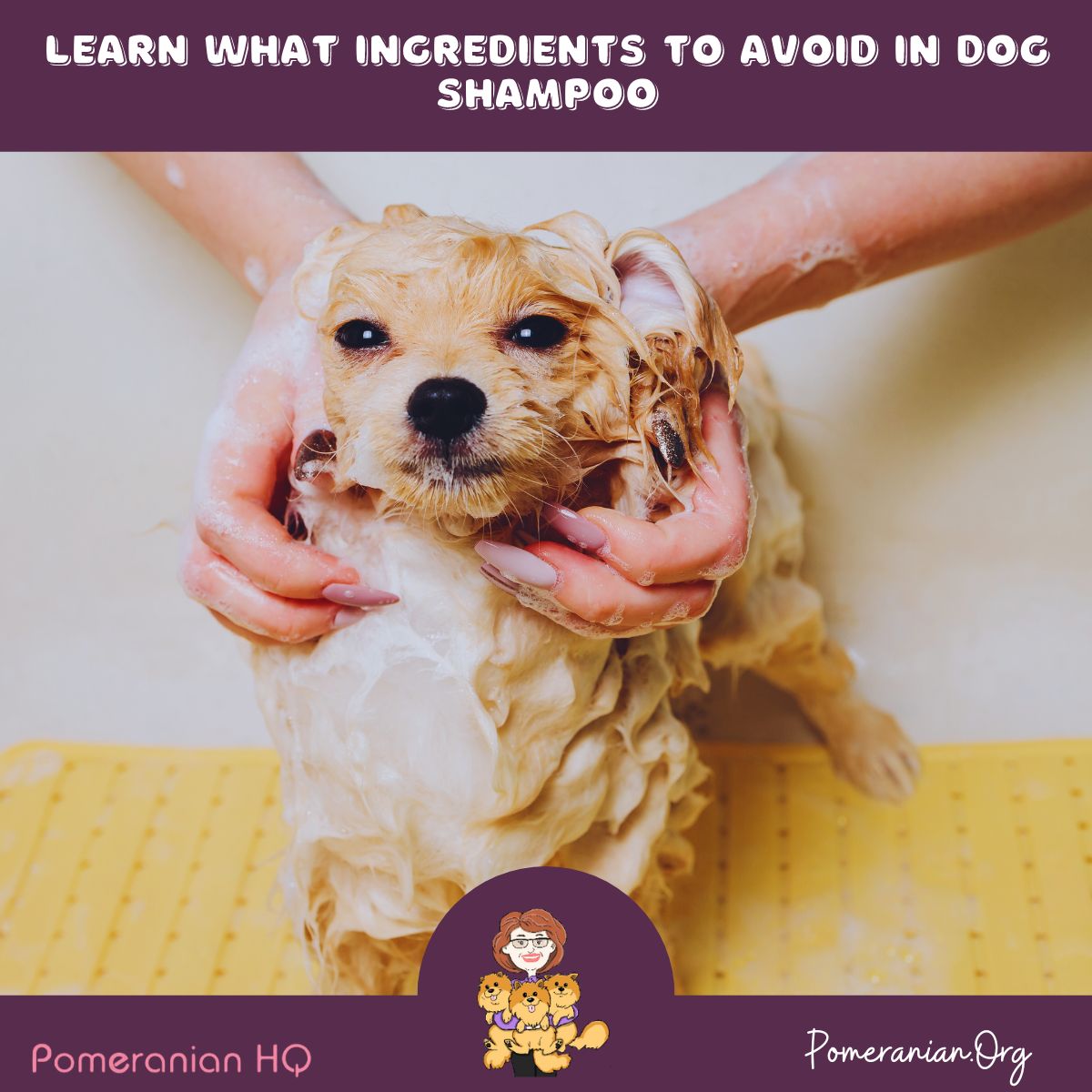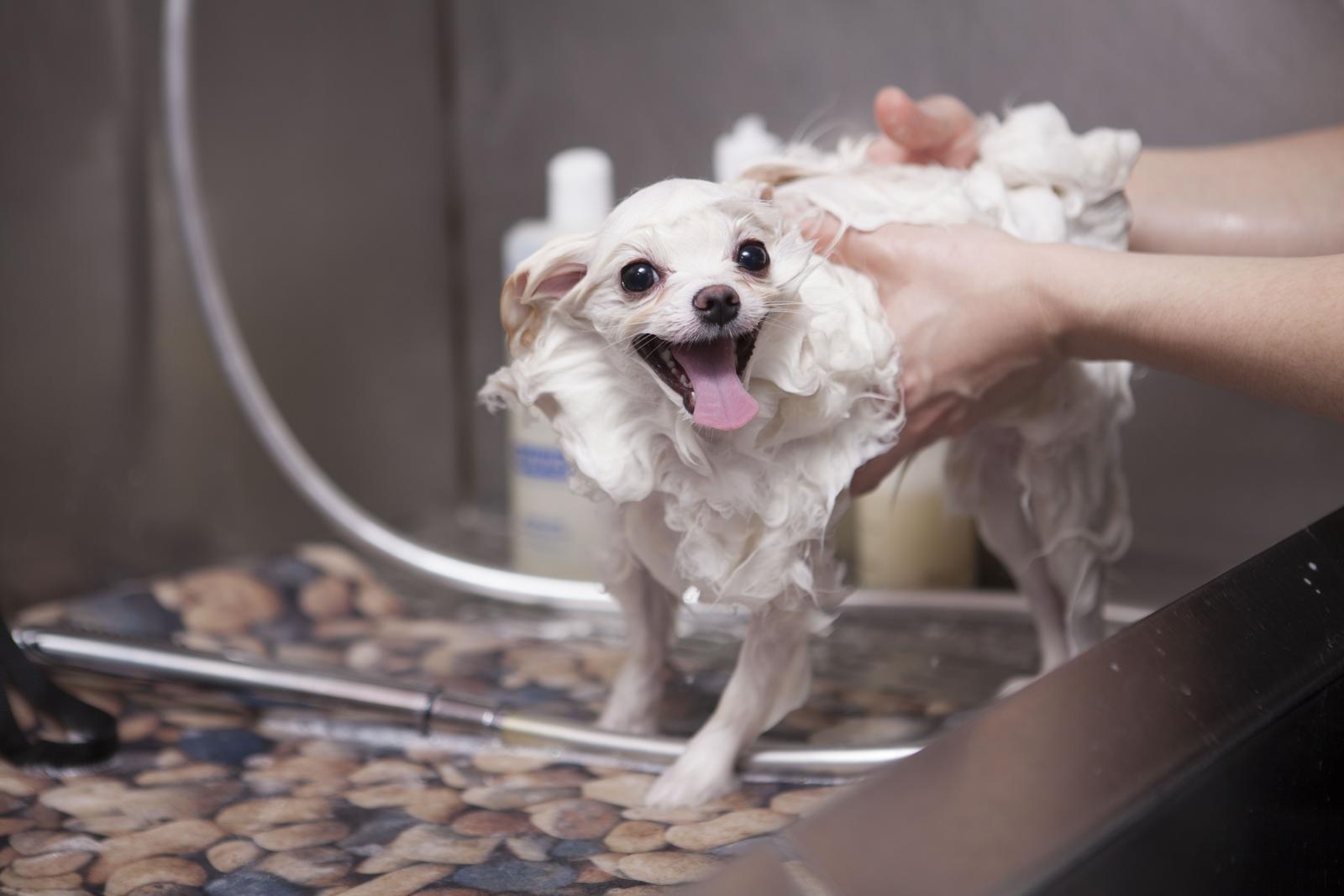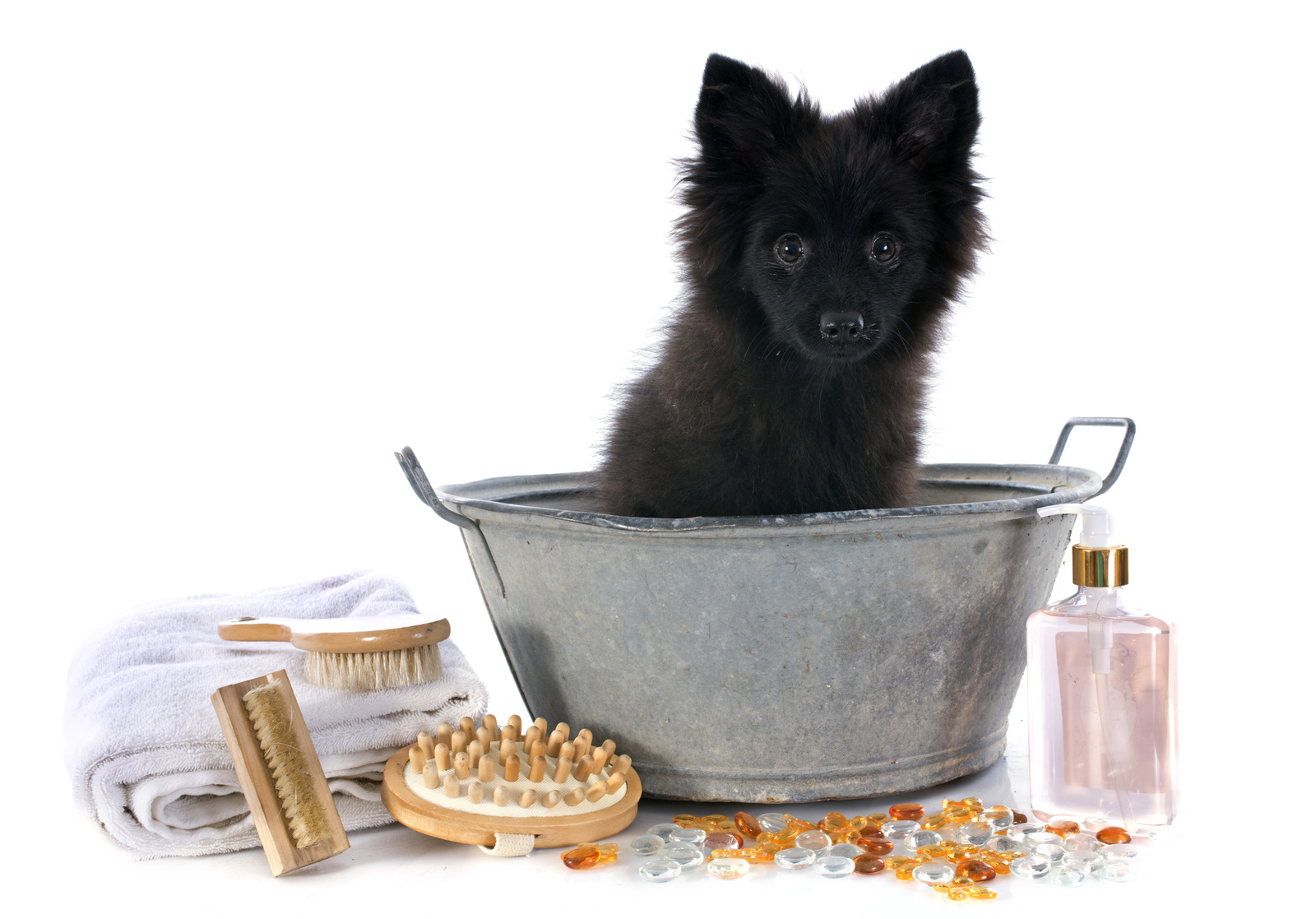Last Updated on 12/04/2023 by Dochlaggie. Post first published on April 12, 2023.
As a Pomeranian owner, you want the best for your dog’s coat. However, knowing which ones are safe and effective for your pup can be challenging with so many shampoo ingredients.
To help you take better care of your fluffball companion, we’ve researched various shampoos currently available on the market and have discovered the key ingredients that should be in any quality product. Learn more about which brand names contain these great ingredients and how they benefit you and your furry friend!
Many shampoos have been designed to address various skin problems cats and dogs face. It may be difficult to understand how the ingredients actually work.

From active ingredients like oatmeal and aloe vera to natural oils like lavender, a variety of compounds can be used in dog shampoos for their specific needs.
Regarding safety and effectiveness, consider purchasing a dog shampoo that includes all-natural ingredients from the list mentioned above. Of course, always read a product’s label before buying and look out for certain artificial ingredients, scents, or other chemicals you’d rather avoid.
Doing so will ensure you find alternatives matching your pup’s chemistry and grooming routine. The best tip is to research different shampoos and determine which is best suited for the health of your pet’s coat.
Learn What Ingredients to Avoid in Dog Shampoo
This table will help improve your understanding of why particular ingredients have been added to shampoo.
Alongside discussions with your vet, this knowledge will help you choose the best product(s) for your dog’s skin problems.
The following table should help you understand why certain ingredients are included in dog shampoo.
This information can help you, with consultation from your veterinarian, select the right one for your pet’s skin condition.
|
INGREDIENTS
|
COMMENTS
|
| INSECTICIDAL | To treat and prevent fleas, ticks, and some types of mange. |
|
Pyrethrin
| |
|
Pyrethroids such as permethrin
|
Don’t use on cats.
|
|
ANTISEBORRHEIC
|
For the prevention and removal of scales and, in many cases, to also get rid of excess oils.
|
|
For seborrhoea oleosa
| Characterized by excess oil and scales. |
|
Sulfur
| Removes crust and scales. Antifungal & Antibacterial. Decreases the amount of itchiness. Best used when combined with the same amount of concentration of salicylic acid. |
|
Salicylic acid
| Removes scale and crust and reduces scale production. Decreases the amount of itchiness. Antibacterial. Works best when used with an equal concentration of sulfur. |
|
Refined Tar
| This is the most powerful ingredient to decrease the number of scales being made. Decreases the amount of itchiness. Degreases May be irritating to your pet. Don’t use on cats. |
| Selenium sulfide | Removes scale and crust and reduces scale production Antifungal & Antibacterial. Degreases Can irritate mucous membranes and scrotum. Only use it for severe oiliness or yeast infections. Needs to stay on for a minimum of 10 minutes for the antifungal properties to work fully. Don’t use on cats. |
|
Benzoyl peroxide
|
Gets rid of crusts and scales. May dry out your pet’s skin. Antibacterial properties. Flushes hair follicles. Great degreaser.
|
|
For seborrhoea sicca
| Characterized by dry scales. |
|
Sulfur
|
Removes crust and removes and reduces the production of scales. Antibacterial. Reduces itching Is ideal when combined with the same amount of sulfur.
|
|
ANTIPRURITIC
| To ease itchiness caused by problems such as atopy and other allergies. |
|
Colloidal Oatmeal
| Decreases the amount of inflammation and skin irrition. |
|
Hydrocortisone
|
Minimal side effects as compared to oral Steroids
|
|
Aloe vera
| |
|
Pramoxine Hydrochloride
| Topical anesthetic |
|
Diphenhydramine
| Antihistamine helps reduce inflammation. |
|
Menthol
| Has a cooling and anesthetizing effect |
|
Sulfur
| Removes crust and removes and reduces the production of scales. Antifungal & Antibacterial. Decreases itchiness. It performs at its best when combined with equal salicylic acid. |
|
Salicylic acid
|
Removes crust and removes and reduces the production of scales. Antibacterial. Reduces itching Is ideal when combined with the same amount of sulfur.
|
|
Cool water rinses
| |
|
ANTIBACTERIALS
|
For treatment of bacterial infections such as pyoderma, folliculitis, and impetigo
|
|
Benzoyl Peroxide
| Gets rid of crusts and scales. May dry out your pet’s skin. Antibacterial. Terrific degreaser, and it flushes out the hair follicles. |
|
Chlorhexidine
|
Higher concentrations may dry out or irritate the skin of some animals.
|
|
Povidone Iodine
| |
|
Triclosan
|
Low potency
|
|
Ethyl Lactate
| Helps flush follicles and helps to degrease |
|
Sulfur
| Removes crust and removes and reduces the production of scales. Antibacterial & Antifungal. Reduces itching. Is ideal when combined with the same amount of salicylic acid May protect against Staph infections. |
|
ANTIFUNGALS
|
To treat yeast infections and ringworm
|
|
Miconazole 2%
|
Cheaper than ketoconazole
|
|
Chlorhexidine 2-4%
|
Some activity against yeast and less activity against ringworm. Higher concentrations may dry the skin or be irritating in some animals.
|
|
Povidone Iodine
|
Not as effective and may be irritating
|
|
Ketoconazole 2%
|
Very effective
|
|
Selenium sulfide 1%
| Gets rid of crusts and scales and reduces the production of scale. Antifungal/Antibacterial. Degreases. May irritate mucous membranes and scrotum. It’s better to only use it in cases of severe oiliness or yeast infections. Must be left on for a minimum of 10 minutes so its antifungal activities kick in. Don’t ever use on cats. |
|
EMOLLIENTS
| Add oils to the skin. |
|
Almond Oil
| |
|
Corn Oil
| |
|
Cottonseed Oil
| |
|
Olive Oil
| |
|
Peanut Oil
| |
|
Persia Oil
| |
|
Safflower Oil
| |
|
Sesame Oil
| |
|
Lanolin
| |
|
Mineral Oil
| |
|
Paraffin
| |
|
EMULSIFIERS
|
Help distribute emollients
|
|
Cetyl Alcohol
| |
|
Laureth-5
| |
|
Lecithin
| |
|
PEG-4 dilaurate
| |
|
Stearic acid
| |
|
Stearyl alcohol
| |
|
HUMECTANTS
|
Rehydrate skin
|
|
Carboxylic Acid
| |
|
Lactic Acid
| |
|
Urea
| |
|
Sodium Lactate
| |
|
Propylene Glycol
| |
|
Glycerine
| |
|
Polyvinylpyrrolidone
| |
|
SPECIAL FORMULATIONS
|
Microscopic particles that will have numerous ingredients that stick to the hair and skin and slowly release their contents
|
|
Novosomes®
|
Release contents over a 7-10 day period.
|
|
Spherulites®
| Release contents over eight days. |
Dog Shampoo Ingredients To Avoid
Not all pet products are created equal – some use harsh, toxic ingredients that could harm your pup. You can always check the label for these dangerous ingredients and harmful chemicals. To ensure you use a natural, safe product to keep your dog happy and healthy!
- Synthetic fragrances are no innocence in disguise; they contain an array of mysterious ingredients that don’t need to be disclosed on their labels, some of which have been linked to serious health concerns such as cancer and reproductive toxicity.
- When shopping for dog shampoo brands, keep an eye out for manufacturers that list a “proprietary blend of coat and skin conditioners and moisturizers” as the only ingredients. This term is often used to mask undisclosed or potentially harmful elements in their products – it’s best to avoid these shampoos entirely!
- Artificially colored products may look bright and vivid, but these colors come with a dark side. Synthesized from petroleum, many potential health risks associated with artificial colors include organ damage, cancerous tumors, congenital disabilities, and allergies – all consequences that can be devastating for victims.
- Phthalates are often used in fragrances without being listed on the label, making it hard for consumers to avoid them. These compounds can significantly impact hormone production and lead to endocrine issues. Be sure to pay attention next time you’re reading dog shampoo ingredients.
- Isothiazolinone preservatives, such as Methylisothiazolinone and Methylchloroisothiazolinone, can cause adverse effects on the skin—ranging from mild irritations to severe allergic reactions. Studies suggest that one of these compounds could also be a neurotoxin capable of damaging the nervous system.
- Many shampoos and other beauty products contain preservatives with names like Bromopol, Doazolidinyl urea, DMDM Hydantoin, Imidazolidinyl Urea, or Quaternium-7. Though it’s not listed as formaldehyde on the label, these chemicals all have a hidden connection to this highly toxic compound – triggering an immune response marked by burning skin irritation. However, more testing is needed for conclusive evidence of any cancer links associated with these ingredients – it is best to steer clear of them altogether.
- Parabens, commonly found in beauty products and kitchen pantries alike, pose serious health risks such as increased cancer or interference with reproductive systems due to their accumulation within the body. To spot them on labels, look out for butylparaben, methylparaben, and Propylparaben.
- Cocamide-MEA, a surfactant, can be incredibly dangerous when not monitored correctly. Triethanolamine, or Cocamide-TEA, is a common surfactant and pH adjuster in many products. Unfortunately, it’s considered high risk for being contaminated with nitrosamines – just like its close chemical cousin bearing the same dangers: Cocamide-MEA.
- Mineral oil is often used in pet shampoos to provide a protective barrier over the skin, keeping it from losing moisture. While this might sound beneficial, there is more to consider—mainly potential toxins and allergens in crude oil-based mineral oils.
- SD Alcohol 40, known as isopropyl or SD-40, dries skin and hair oils. Furthermore, it can increase absorption through the skin of other potentially toxic ingredients in products containing this alcohol. Due to its properties, many ear-cleaning solutions use it as one of their main components.
- Polyethylene glycol, or PEG, has long been a mainstay in skincare products to help the skin retain moisture. However, what you may not know about this humectant is that it also acts as a “penetration enhancer,” allowing other chemicals and potentially toxic contaminants like dioxane and ethylene oxide to enter the bloodstream more easily upon contact with the skin.
- Propylene glycol is a multifaceted ingredient commonly used in skincare and beauty products. Though it acts as a skin conditioner, solvent, and humectant, studies suggest that long-term exposure to propylene glycol may be toxic for the immune system, nervous system, reproductive organs – even the skin itself!
- PEG-40 Lanolin is a relative of lanolin, typically derived from sheep’s wool. Unfortunately, studies show that there could be potential organ toxicity associated with its use– and even worse – possible contamination by dioxane or ethylene oxide.

More Dog Shampoo Ingredients To Avoid
Unregulated manufacturing of pet products means that six skin-irritating and potentially allergic ingredients could be contaminated with toxic byproducts without you knowing. Sadly, no governing agency sets standards to prevent this from happening or even tests these formulations for contaminants – leaving our furry friends at risk!
To ensure your dog’s safety and health, steer clear of these ingredients when selecting a dog shampoo:
- Dog owners often wonder about the safety of sodium benzoate for their furry friends. Unfortunately, when combined with citric or ascorbic acid (vitamin C), it may form benzene – an element linked to cancer and other severe blood disorders. However, if kept separate from these acids, this preservative is generally considered safe for pets.
- Sodium Lauryl Sulfate (SLS) is a powerful chemical in many everyday products. Despite its wide usage, the powder form can be highly hazardous to the skin.
- Sodium Laureth Sulfate is a popular cleaning agent derived from coconut oil, often marketed as “natural” and vegan-friendly. However, research has revealed that it’s at risk of contamination by carcinogens 1,4-dioxane and ethylene oxide — known to cause health complications such as cancer or allergies.
- Ammonium Laureth Sulfate’s status as a surfactant may be misleading; this chemical is known to cause skin irritation and could even contain traces of potentially toxic dioxane or ethylene oxide.
- Cocamidopropyl betaine is a foaming agent and synthetic surfactant derived from coconut oil that can potentially cause skin irritation or allergic reactions. The manufacturing process can leave specific contaminants behind, such as amidoamine and 3-dimethylaminopropylamine, which may form nitrosamines when exposed to high temperatures or acidic conditions.
- Polysorbates are commonly used to give cosmetics and other products a pleasurable scent, provide stability for the ingredients in a product, or act as an emulsifier. Starting as sorbitol—a sugar alcohol derived from corn syrup — this ingredient is treated with ethylene oxide, determining its number: 20 parts of ethanol make it into Polysorbate 20. However, it may contain carcinogenic compounds if not entirely removed during processing.

Dog Shampoo Ingredients Conclusion
To summarize, knowing which dog shampoo ingredients to look for and which to avoid is the key to healthy grooming for your pet. It’s essential to research the ingredients before purchasing shampoo and ensure they are safe and effective.
If something isn’t on the label, you can ask the manufacturer what it means or find another product with more transparent ingredients. With frequent baths and proper care of the dog’s coat, you’re sure to have a healthy and happy pup in no time!
You’ll help keep their skin and fur clean, nourished, and free from irritation by identifying good dog shampoo ingredients.
Furthermore, suppose you believe your pet may have any allergic reactions or irritation from certain shampoos. In that case, seeking veterinary advice before using those products is best. Pomeranian Headquarters hope this blog post was informative enough for you to pick out the next one for your dog confidently!
Please note: while I do discuss health, care, and behavioral issues, you should never use this information as a replacement for advice from qualified veterinarians, diagnoses, or recommended treatment regimes. If you have any worries about the health of your Pomeranian, your first contact should be your regular vet or, if you don’t yet have one, a vet that works locally. Never ignore or avoid treatment and advice from your vet because of a piece of information you have read on any website.
Copyright Pomeranian.org. All Rights Reserved.
References and Further Reading:
[1] Official Standard of the Pomeranian (AKC). American Kennel Club, 2011.
[2] English Kennel Club Pomeranian Breed Standard, 2017.
[3] Denise Leo, The Pomeranian Handbook.
[4] Milo G. Denlinger “The Complete Pomeranian.”
[5] Kimbering Pomeranians “1891-1991”.
[6] William Taplin’s “The Sportsman’s Cabinet.”
[7] E. Parker “The Popular Pomeranian.”
[8] Lilla Ives “Show Pomeranians.”







